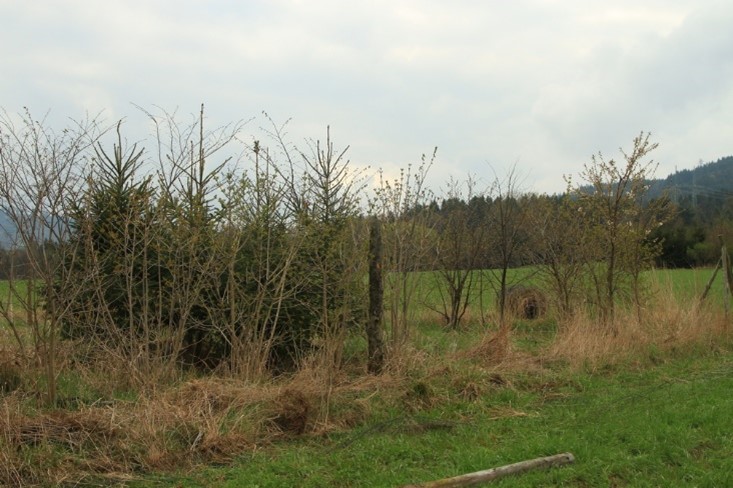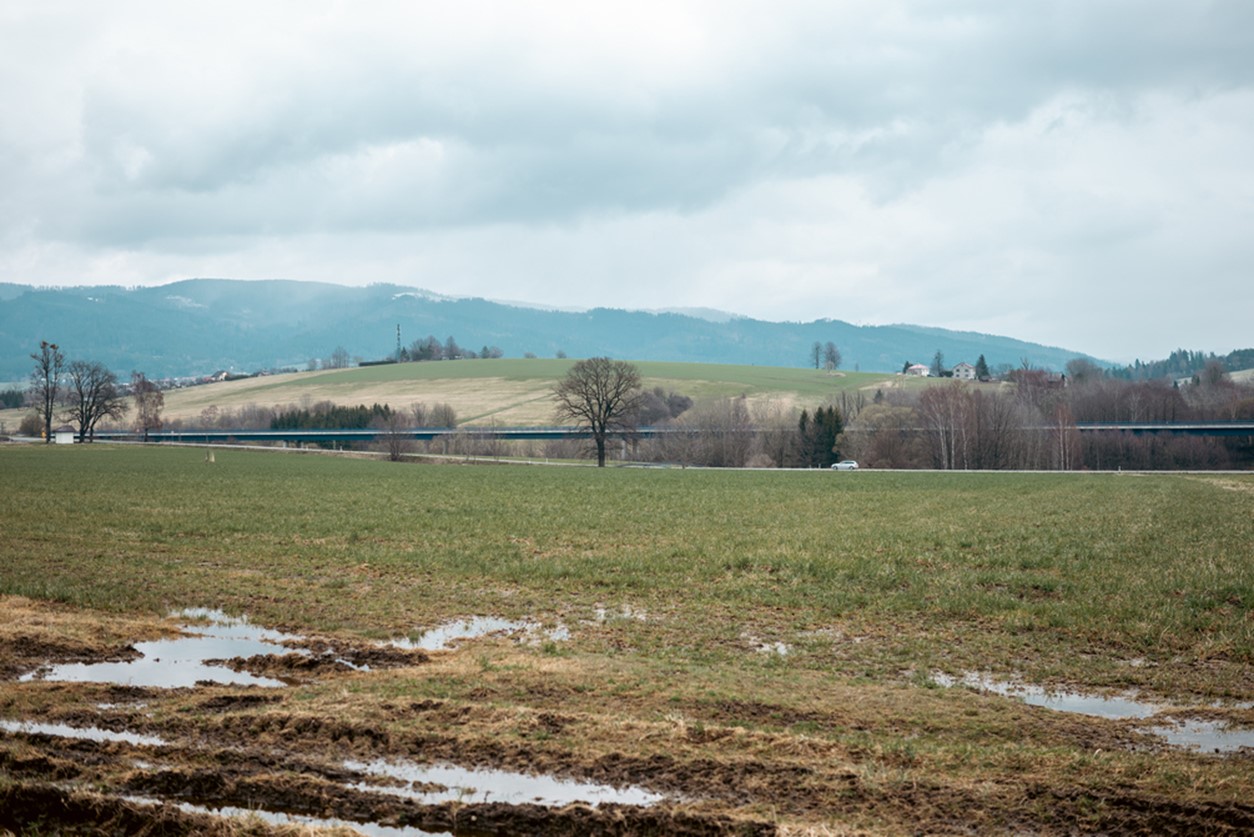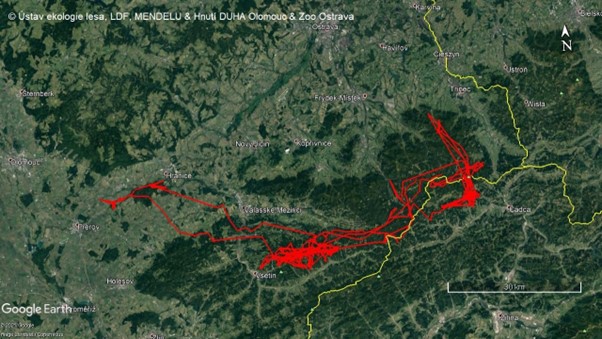SaveGREEN - Update on the restoration of guiding vegetation in the Jablunkov migration corridor, plus some outcomes of telemetry monitoring of lynx in the Beskydy Mountains
27-05-2022
After more than a year of GPS tracking of five male lynx in the Beskydy Mountains, the first results are in. Using telemetry monitoring, researchers from Mendel University in Brno have mapped the migration routes of these large carnivores, and have also identified which sections are of critical importance in terms of connectivity. Meanwhile, Friends of the Earth Czech Republic (Hnutí DUHA Olomouc) has been using camera traps to monitor landscape permeability in the Beskydy and Kysuce Mountains as part of the international project SaveGREEN,[i] of which the Transport Research Centre is a partner. Today, Hnutí DUHA Olomouc staff and volunteers continue to work on restoring the migration corridor of large carnivores and other animal species near the town of Jablunkov. One ongoing task is the removal of protective fencing that surrounds guiding vegetation.


Hnutí DUHA Olomouc volunteers remove protective fencing in the migration corridor.
Source: Ivo Dostál, Transport Research Centre
Green paths
In 2010, Jablunkov authorities took the decision in their zoning plans to protect the nearby migration corridor for large mammals as a ‘non-building area’ saying:[ii] “The migration routes of endangered species such as wolves, lynx, bears and other animals lead down from the Silesian Beskydy Mountains, under the I/11 road bridge, across an agricultural area and through a railway underpass to the Beskydy Protected Landscape Area.”
“Several years ago,[iii] together with the town of Jablunkov and the Gírová Hunting Association, we arranged for the planting of guiding vegetation between the road bridge and the underpass,” says Radek Kříček, head of the SaveGREEN project at Hnutí DUHA Olomouc. “We have removed protective fencing from almost all the replanted areas. Thus, the corridor can start serving its full purpose- Kříček added. The greenery will help animals to find a safe way across the Jablunkov depression, while also providing food and shelter.”

The migration corridor continues under the road bridge and connects the Silesian and Moravian-Silesian Beskids. Source: Friends of the Earth Czech Republic (Hnutí DUHA Olomouc)
The construction of a new eco-duct is due to start in 2024 at the nearby village of Mosty u Jablunkova.[iv] This will be the first ‘green bridge’ in the Czech Republic that bears might possibly use. The eco-duct will be built near the Slovak border town of Svrčinovec and become operable in 2025. At the same time, another green bridge is to be built near the same town on the Slovak side of the border.
Tracking lynx
The first results from the telemetry tracking of five male lynx in the Beskydy Mountains show just how important it is for large carnivores to be able to move freely through the landscape. Mendel University researchers conducted the monitoring for more than a year as part of the SaveGREEN project, which focuses on landscape permeability.
“Telemetry monitoring has provided us with several valuable insights,” says Martin Duľa, a zoologist at Mendel University’s Institute of Forest Ecology. “For one, the lynx move over a large area, with home ranges for resident individuals of between 212 and 364 square kilometres. One sub-adult male, Eman, roamed over an area of more than 2,000 square kilometres, between Lipník nad Bečvou and Čadca, in search of new territory.”

Telemetry monitoring shows that Eman, a young lynx, roamed over an area of more than 2,000 km2. Source: FFWT Mendelu
The zoologist adds that his team have identified several critical points which are crucial in terms of population connectivity. One of them is the Pindula Pass: “The male lynx Květoslav has crossed the road there – which has a traffic volume of about 8,000 cars per day – at least 20 times,” Duľa exclaims.
In addition, more than 200 lynx’s prey have also been tracked, with roe deer predominant – about 80%. Duľa and his colleagues will continue to process detailed results on spatiotemporal and foraging, while the Transport Research Centre is helping to interpret the results.
Photo-monitoring
Hnutí DUHA Olomouc is meanwhile carrying out extensive photo-monitoring of endangered carnivores within the scope of the SaveGREEN project. The results demonstrate the functionality of some previously identified migration corridors that could be severely impacted from several construction projects in the works.
“Last year, with the use of camera traps, we were able to map the journey of a young female lynx born in the Beskydy Mountains,” says Michal Bojda, a field worker with Hnutí DUHA Olomouc. “She repeatedly crossed the Lyský Pass, which separates the Javorníky Mountains from the White Carpathians. The pass consists of a main road and a double-track railway. The R49 expressway, if built as planned, will pass right through here, but it’s a crucial point for maintaining habitat connectivity between the Beskydy Protected Landscape Area and the adjacent peripheral parts of the Western Carpathians, such as the White Carpathians or the Hostýnské and Vizovické Hills.”

Photomonitoring has identified the Lyský Pass as one of the important points for the movement of large carnivores.
One of the animals regularly crossing here was the female lynx Žakelína.
Source: Friends of the Earth Czech Republic (Hnutí DUHA Olomouc)
Ivo Dostál, a researcher at the Transport Research Centre, concludes with his thoughts on the situation in the pilot area: “In the case of animals dispersing over long distances – such as wolves, lynx or bears – it’s not enough to protect just the core areas. The most critical places are in the adjacent intensively populated valleys. For the Beskydy populations – in addition to the valleys within the mountain range itself – it’s also important to maintain connectivity in the Lower and Upper Moravian valleys [with the D55 and D1 roads under construction], the Moravian Gate [D1] and, on the Slovak side, in the Kysuce valley [D3] and the Váh valley [D1].”
Contacts
Radek Kříček, head of the SaveGREEN project at Hnutí DUHA Olomouc
E-mail: radek.kricek@hnutiduha.cz
Phone: +420 723 435 156
Martin Duľa, a zoologist at the Institute of Forest Ecology, Mendel University in Brno
E-mail: martin.dula@mendelu.cz
Phone: +420 770 137 635
Michal Bojda, a field worker at Hnutí DUHA Olomouc
E-mail: michal.bojda@hnutiduha.cz
Phone: +420 734 233 993
Selmy, Czech Republic, 2022
Transport Research Centre
[i] The SaveGREEN project, funded by the European Union (ERDF) through the Interreg Danube Transnational Cooperation Programme (DTP), addresses the critical issue of ecological corridors in the Carpathian and other mountain ranges in the Danube region. See more information here.
[ii] See more information here.
[iii] See more information here.
[iv] See the official information leaflet for construction details.
